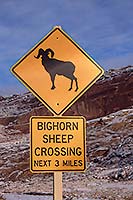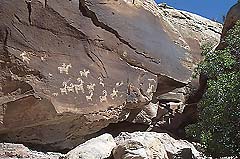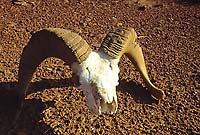 There is little argument amongst Canyon Country explorers that a desert bighorn sheep sighting is a hiking highlight. Perhaps it is due to the scarcity of these creatures, once common in the Southwest, but now greatly reduced from impacts over the past 200 years.
There is little argument amongst Canyon Country explorers that a desert bighorn sheep sighting is a hiking highlight. Perhaps it is due to the scarcity of these creatures, once common in the Southwest, but now greatly reduced from impacts over the past 200 years.
With compact and muscular bodies, desert bighorns are well-adapted to the rigors of desert life. Powerful legs enable the sheep to climb steep rocky slopes or to plunge off of high ledges without missing a stride when evading predators such as mountain lions or coyotes. The desert sheep have split hooves with a hard outer rim surrounding a softer, spongy center that provides grip on rocky surfaces.
Biologists believe that the ancestors of these desert sheep first migrated to North America across the Bering Land Bridge to North America between 750,000 and one million years ago. Groups of sheep splintered off to inhabit various regions such as interior mountain ranges and desert canyons. Today, several subspecies of Ovis canadensis are recognized, and the desert dwelling subspecies that inhabits the Canyon Country and portions of the Southwest from California to west Texas is O. canadensis nelson.
Early native inhabitants of this region hunted bighorn and utilized the meat, hides, bones, and horns for tools. A bighorn’s horns are made of keratin, the same compound found in fingernails, feathers, and hooves. The keratin serves to absorb the energy released in the head-to-head clashes. Indigenous tribes utilized horns of both the male and female sheep to make a variety of tools such as digging sticks and food utensils by steaming the hollow core, then flattening it to form a base material from which a needed tool could be formed.
Back in 1776, when the Spanish Domínguez-Escalante Expedition passed through the region, the Franciscan missionary Silvestre Vélez de Escalante noted in his journal the abundance of wild sheep as determined by their tracks and other sign. Unfortunately, as traders, settlers, and pioneers entered the region, populations of these wild sheep diminished as they were hunted for food or fell to diseases. Today, an estimated 600 bighorns inhabit the Canyonlands region, mostly in remote and inaccessible areas.

Fall is a great time to view bighorns during their rut. Bands of ewes and young gather together with various age-class rams. With the focus on the breeding season, it’s a great time to watch displays such as charges, lip-curling, sniffing, and the classic clashing of the Titans type of activity: head butting. The lucky observer can enjoy this impressive sight but even someone a mile away may hear the “rifle shot like” sound of males colliding.
.jpg) In winter, after the rut, some of the males may disperse back to their bachelor haunts while others forage alongside the ewes, yearlings, and lambs. But no matter the time of year, recreationalists including hikers, cyclists, rafters, and jeepers are encourage to stay a respective distance from these creatures. In particular, sheep that are lying down may seem inactive but with their four-part stomach, these animals may be digesting the large quantity of plant material they consumed earlier in the day. The bighorns do what they do, and for us humans to continue experiencing these majestic creatures, we need to give them the space they deserve.
In winter, after the rut, some of the males may disperse back to their bachelor haunts while others forage alongside the ewes, yearlings, and lambs. But no matter the time of year, recreationalists including hikers, cyclists, rafters, and jeepers are encourage to stay a respective distance from these creatures. In particular, sheep that are lying down may seem inactive but with their four-part stomach, these animals may be digesting the large quantity of plant material they consumed earlier in the day. The bighorns do what they do, and for us humans to continue experiencing these majestic creatures, we need to give them the space they deserve.